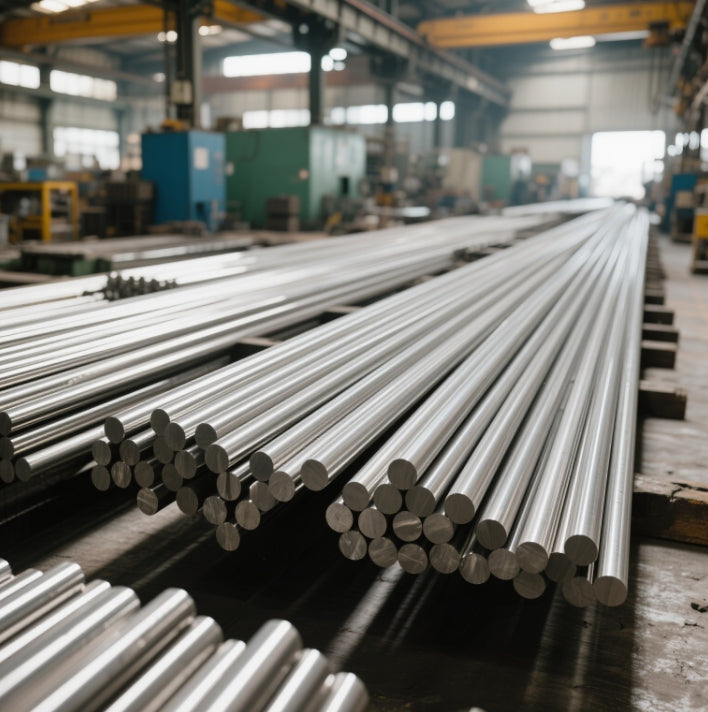StockSteel
Polished Stainless Steel Rod | Aesthetic & Functional
Polished Stainless Steel Rod | Aesthetic & Functional
Couldn't load pickup availability
Polished Stainless Steel Rod | Aesthetic & Functional
Product Specifications
| Parameter | Details |
|---|---|
| Material Grades | 316 stainless steel rod (AISI 316L, UNS S31603), 304, 17-4 PH, 2205 Duplex |
| Diameter Range | Round Rods: 3–2000mm; Custom Shapes: boat rod holders stainless steel (16–50mm) |
| Length | 0.1–12m (Standard), Custom Lengths Available |
| Hardness (HV) | 150–200 HV (316L); 250–350 HV (Cold-Worked Grades) |
| Tensile Strength | 520–860 MPa (316L); 700–1000 MPa (17-4 PH); 800–1200 MPa (Duplex 2205) |
| Surface Finish | Polished (#4–#8 Mirror), BA (Bright Annealed), Passivated, Electroplated (Optional) |
| Welding Compatibility | filler rod for tig welding stainless steel (ER316L/308L), MIG, Laser Welding |
| Certifications | ISO 9001, ASTM A276, EN 10088, NACE MR0175 (H₂S Resistance) |
Mechanical & Chemical Properties
Tensile Strength
The 316 stainless steel rod excels in tensile strength (520–860 MPa), making it ideal for marine and chemical environments due to its 2–3% molybdenum content. This alloy resists chloride-induced pitting corrosion, outperforming standard 304 grades by 40% in saltwater exposure. For high-stress applications like boat rod holders stainless steel, duplex 2205 rods combine austenitic-ferritic microstructure to achieve 800–1200 MPa tensile strength, ideal for offshore rigs.
Bend Strength
Polished rods exhibit bend strengths of 60–70% of tensile strength. The 316 stainless steel rod maintains structural integrity even under dynamic loads, crucial for marine hardware exposed to wave impacts. Cold-drawn 17-4 PH rods enhance bend resistance by 30%, perfect for aerospace fasteners.
Identification & Marking
Stainless steel rods are labeled per global standards:
- ASTM A276: Specifies chemical composition for 316 stainless steel rod (16% Cr, 10% Ni, 2% Mo).
- ISO 15510: Ensures traceability for marine-grade alloys.
- NACE MR0175: Certifies H₂S resistance for oilfield applications.
Laser etching ensures permanent marking of grade, batch, and tensile class.
Weight Calculation
Weight (kg) = Volume (m³) × Density (7,930 kg/m³ for 316L).
Example for a 10mm diameter, 1m rod:π × (0.005m)² × 1m × 7,930 kg/m³ ≈ 0.62 kg.
For boat rod holders stainless steel (20mm diameter):Weight ≈ 2.48 kg/m. Custom weights vary with alloy density and surface treatments.
Why Stainless Steel Rusts: Causes & Solutions
While stainless steel resists corrosion via a chromium oxide layer (≥10.5% Cr), specific conditions trigger rust:
- Chloride Exposure: Saltwater degrades passive layers. 316 stainless steel rod with molybdenum mitigates this.
- Galvanic Corrosion: Contact with carbon steel accelerates oxidation. Insulate metals using dielectric coatings.
- Mechanical Damage: Scratches expose iron. Passivate surfaces with nitric acid post-fabrication.
- Low Oxygen: Stagnant water in crevices (e.g., welded joints) breeds corrosion. Design gaps >0.5mm.
Why Choose Our Stainless Steel Rods
- Certified Quality: ISO 9001 and ASTM-compliant production with SGS/BV third-party inspections.
- Customization: Tailor 316 stainless steel rod, boat rod holders, or filler rod for tig welding stainless steel to exact dimensions (±0.1mm tolerance).
- Fast Delivery: 15–30-day lead time via DHL/FedEx global logistics.
- Sustainability: 100% recyclable alloys; lean duplex grades reduce nickel consumption by 50%.
- Technical Support: Expert guidance on welding parameters (TIG/MIG) and corrosion prevention.

